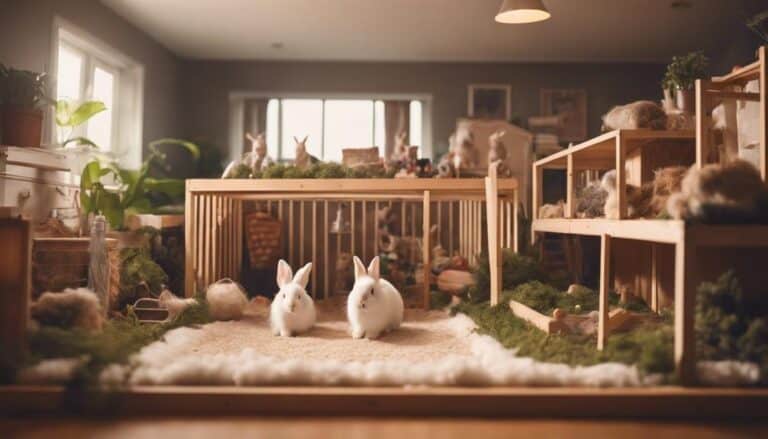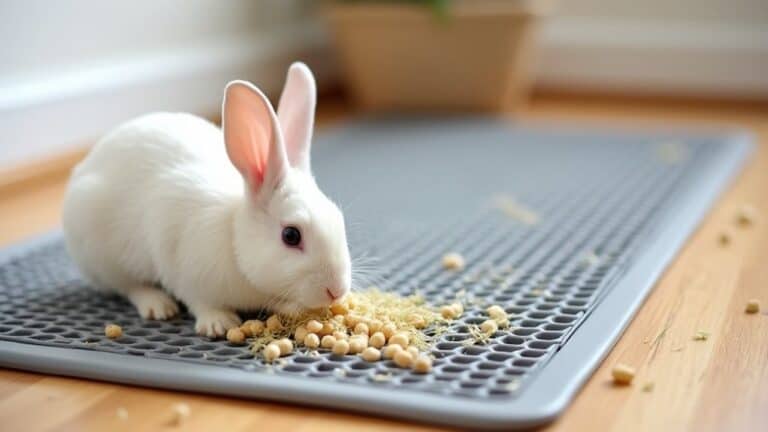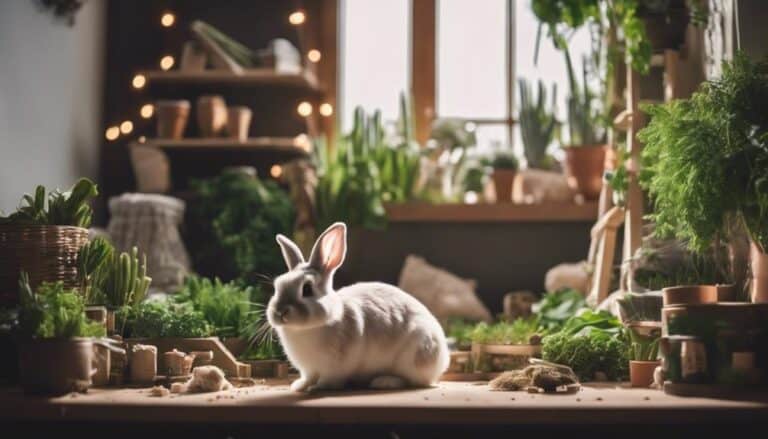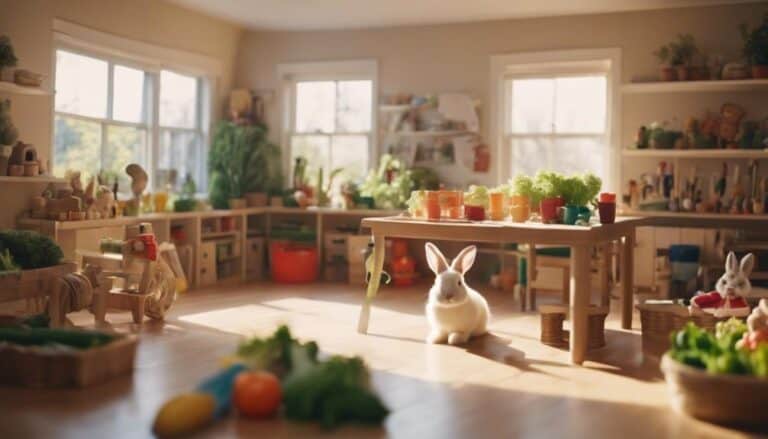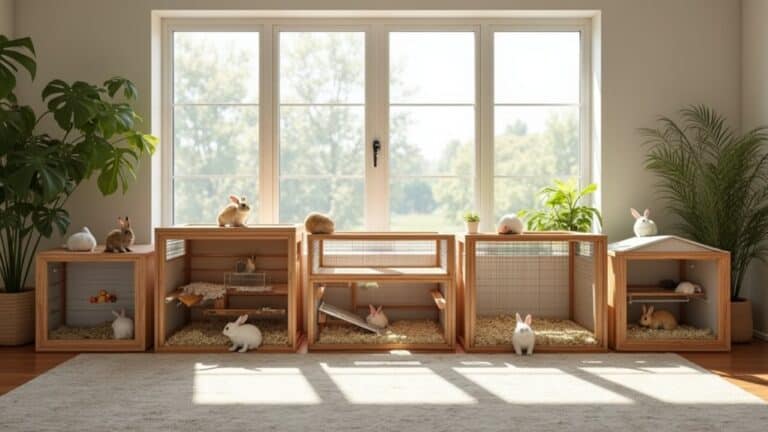When it comes to creating a harmonious living space for you and your bunny, ensuring their safety is key.
Imagine a world where your furry companion can roam freely without causing mischief or harm.
By implementing simple yet effective bunny-proofing techniques, you can transform your home into a secure haven for your pet.
From safeguarding against potential hazards to providing stimulating alternatives, these tips will not only protect your living space but also nurture a happy relationship with your beloved bunny.
Contents
Key Takeaways
- Use cable wraps and furniture elevation to manage wires and cords effectively.
- Protect baseboards with lattice and corner guards to prevent damage.
- Prevent carpet damage with tiles and rearranged furniture.
- Secure furniture with PVC tubing and provide safe chewing options for bunnies.
Blocking off Wires and Cables
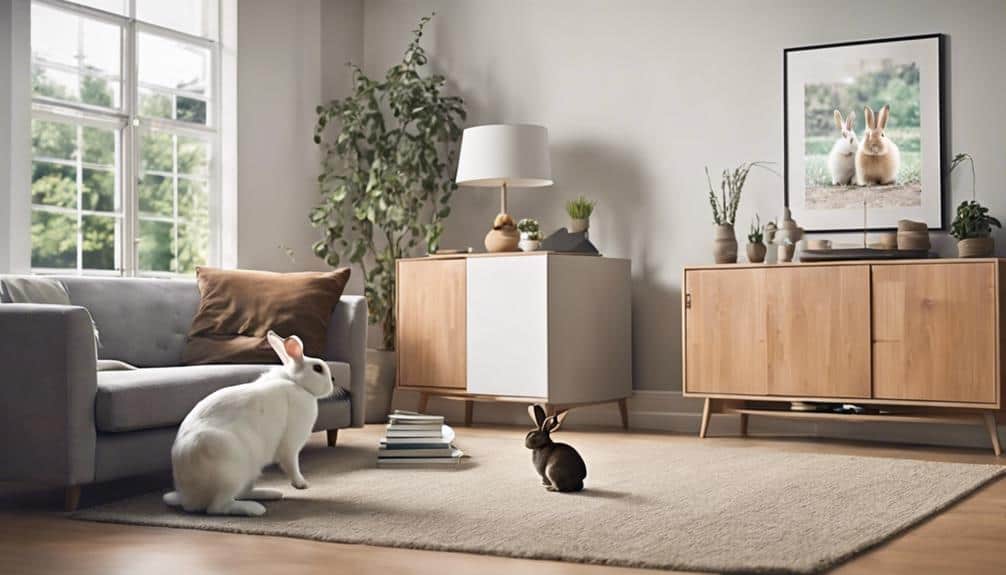
To safeguard your living space from potential damage and keep your furry friend safe, take proactive steps to block off wires and cables effectively. Rabbits have a natural tendency to chew on cords, which can pose a danger to both them and your electrical systems. One way to protect your wires is by using spiral cable wraps or cord concealers. These tools not only safeguard your cords but also provide a barrier that deters your rabbit from chewing on them.
Elevating cords with furniture can also help prevent access and potential damage. By keeping cords out of reach, you reduce the risk of your bunny getting tangled or causing harm. Additionally, consider using floor cable covers to block off wires from curious bunnies. These covers can be an effective way to create a physical barrier that prevents your rabbit from reaching the cords.
Remember to provide alternative chew sticks to redirect your rabbit's attention away from wires. Implementing raceways and wire channels can also help conceal and protect cords from rabbit interference. By employing these strategies, you can effectively bunny-proof your living space and make the safety of both your pet and your home.
Protecting Your Baseboards and Walls
Safeguarding your baseboards and walls from rabbit chewing can be achieved by using plastic lattice or untreated wood boards as protective barriers. These materials act as a physical barrier, preventing your rabbits from gnawing on the baseboards and walls.
Additionally, secure your baseboards with vinyl baseboard covers to provide an extra layer of protection against rabbit teeth. Implement corner protectors, whether made of plastic or wood, to safeguard vulnerable corners that are prone to rabbit chewing.
Address your rabbits' favorite chewing spots with untreated wood attachments to deter them from causing damage. Taking proactive measures to prevent rabbit-induced destruction is key to maintaining the integrity of your baseboards.
Preventing Carpet Digging
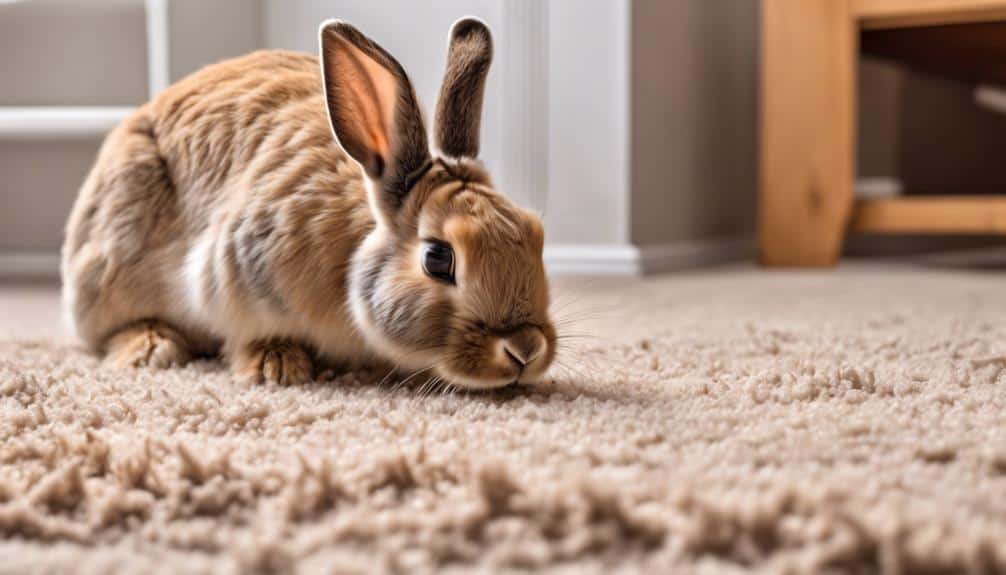
When preventing carpet digging by your bunnies, consider covering vulnerable areas with tiles or sea grass mats. These options provide a sturdy barrier against bunny digging habits, protecting your carpets from potential damage.
Additionally, here are some practical tips to help you safeguard your living space:
- Furniture Rearrangement: Move furniture to cover spots where bunnies tend to dig. This can discourage them from accessing these areas and prevent carpet damage.
- Address Loose Carpet Edges: Secure any loose carpet edges that bunnies may pull and dig at. Ensuring that the carpet is properly fixed in place will help maintain its integrity.
- Untreated Sea Grass Mats: Offer untreated sea grass mats as a chew-friendly alternative for your bunnies. Providing them with appropriate items to chew on can redirect their natural digging behavior away from your carpets.
Securing Furniture and Nesting Areas
Securing your furniture and nesting areas can be achieved by covering furniture legs with PVC tubing or cardboard to protect them from bunny chewing habits. Rabbits have a natural instinct to chew on objects, and your furniture legs might seem like an appealing target. By placing these protective coverings, you create a barrier that discourages them from causing damage.
Additionally, using cube shelves or untreated wood boards can help create barriers to prevent bunnies from accessing hazardous areas or nesting in undesirable spots. Implementing plastic couch guards underneath furniture can also secure these areas and deter rabbits from nesting or chewing. Rearranging your furniture strategically to cover spots where rabbits may dig, preventing destructive behavior.
Providing Safe Chewing and Digging Options

To protect your rabbit's well-being and prevent destructive behaviors, providing a variety of safe chewing and digging options is essential. Here are some tips to help you create a rabbit-friendly environment:
- Wooden Chew Toys: Offer wooden chew toys to satisfy your rabbit's natural urge to chew. This will help keep their teeth healthy and prevent them from gnawing on furniture or other inappropriate items.
- Grass-Based Hay: Provide grass-based hay, such as timothy hay, as a tasty and essential chewing option. Not only does it promote dental health, but it also offers enrichment through foraging.
- Digging Box: Create a digging box filled with safe materials like shredded paper or hay. This will allow your rabbit to indulge in their instinctual digging behaviors without causing damage to your floors. Incorporating tunnels and cardboard boxes within their play area can also provide enrichment and prevent boredom.
Frequently Asked Questions
How Do I Bunny Proof My Backyard?
To bunny-proof your backyard, consider outdoor enclosures, digging deterrents, proper fence height, garden protection, plant safety, burrow prevention, gate security, netting options, hideaway spots, and blocking escape routes. Create a safe haven for your bunnies to explore and enjoy.
How Do You Block an Area From a Rabbit?
To block an area from a rabbit, consider using indoor barriers, pet gates, and temporary fencing. Deterrent sprays, furniture covers, and playpen options can help. Implement DIY solutions, training techniques, and chew toys. Supervised playtime is important.
How Do I Protect My Walls From Rabbits?
To protect your walls from rabbits, consider using plastic corner protectors, untreated wood or lattice attachments, cube shelves, or baby gates as bunny barriers. Provide alternative chew toys like cardboard or applewood sticks for chew prevention.
How Do I Stop My Rabbit From Chewing My Baseboards?
To stop your rabbit from chewing baseboards, consider baseboard alternatives like PVC tubing, use chew deterrents and bitter sprays, train with interactive toys, offer supervised playtime, maintain consistent discipline, utilize bunny-proof barriers, and create DIY chew toys.
What Are Some Tips for Bunny-Proofing Your Living Space?
Bunnyproofing your living space is essential to keep your furry friends safe and your belongings intact. Covering wires, securing furniture, and providing chew toys are all crucial steps in ensuring the importance of bunnyproofing. It’s important to create a safe and enjoyable environment for your pet bunnies.
Conclusion
Congratulations on taking the necessary steps to bunny-proof your living space! Your dedication to creating a safe environment for your furry friend is truly commendable.
Remember, protecting your belongings from potential damage is just an added bonus. Keep up the good work, and your rabbit will thank you for providing a secure and enjoyable home.
Happy bunny-proofing!

